Rick Just's Blog, page 63
April 9, 2023
Territorial Divorce (tap to read)
Divorce is always painful, even if both parties are amicable. We’ve all experienced or none of divorces that were far from friendly.
Dealing with dueling lawyers is bad enough, but what if you also had to deal with the Idaho Legislature?
In the early days of Idaho Territory, couples seeking to split had to appear before the Legislature, which acted as a divorce court.
Here’s an example of what that might look like from an 1881 divorce:
“Be it enacted by the Legislative Assembly of the Territory of Idaho, as follows:
“Section 1. That the bonds of matrimony heretofore and now existing between Martin Fallon and Mary Fallon, his wife, be, and the same are hereby dissolved, and declared void.
“Section 2. This act shall take effect and be in force from and after its passage.
“Approved February 9, 1881.”
No doubt we’d have a full-time Legislature today if that tradition had remained in place.

Dealing with dueling lawyers is bad enough, but what if you also had to deal with the Idaho Legislature?
In the early days of Idaho Territory, couples seeking to split had to appear before the Legislature, which acted as a divorce court.
Here’s an example of what that might look like from an 1881 divorce:
“Be it enacted by the Legislative Assembly of the Territory of Idaho, as follows:
“Section 1. That the bonds of matrimony heretofore and now existing between Martin Fallon and Mary Fallon, his wife, be, and the same are hereby dissolved, and declared void.
“Section 2. This act shall take effect and be in force from and after its passage.
“Approved February 9, 1881.”
No doubt we’d have a full-time Legislature today if that tradition had remained in place.

Published on April 09, 2023 04:00
April 8, 2023
Wings on the Capitol (tap to read)
The Idaho capitol couldn’t fly until it had wings. Old pictures of the statehouse with its familiar dome, spreading stairs, and soaring columns, sans the senate and house wings make the whole thing look a little stubby (below). The east and west additions balanced the look of the building and made it much more functional.
Adding the wings wasn’t as easy as it might seem. First, Legislators had to haggle over an appropriations bill. That gave members from eastern Idaho an excuse to bring up the idea of moving the capital halfway across the state, specifically to Shoshone. They thought the existing building would make a fine university. The idea did not have wings.
Once $900,000 was appropriated for construction of the additions, there was the matter of the state not actually owning the property where they were to go. Boiseans were asked to pass a bond of $135,000 to purchase the property where the wings would be built. The newly acquired property would later be swapped with the state.
Once the Boise bond was passed, the structures on the property had to go away. They included the Central School building, which was being used at the time by the state agriculture department. The Sherman House, a fashionable boarding house once owned by the sister of Mary Hallock Foote would come down, as would Collister Flats, the Aloha Apartments, and four small residences.
The wings, which now host the chambers of the House and Senate as well as other state offices, were completed in 1920.
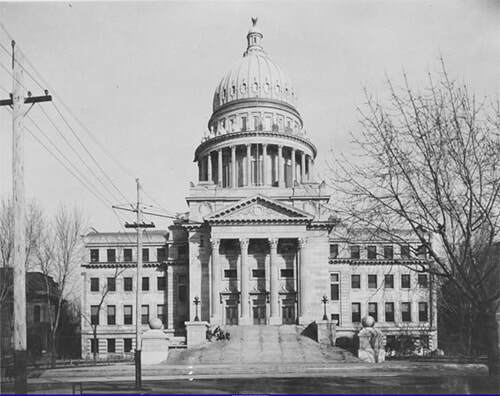
Adding the wings wasn’t as easy as it might seem. First, Legislators had to haggle over an appropriations bill. That gave members from eastern Idaho an excuse to bring up the idea of moving the capital halfway across the state, specifically to Shoshone. They thought the existing building would make a fine university. The idea did not have wings.
Once $900,000 was appropriated for construction of the additions, there was the matter of the state not actually owning the property where they were to go. Boiseans were asked to pass a bond of $135,000 to purchase the property where the wings would be built. The newly acquired property would later be swapped with the state.
Once the Boise bond was passed, the structures on the property had to go away. They included the Central School building, which was being used at the time by the state agriculture department. The Sherman House, a fashionable boarding house once owned by the sister of Mary Hallock Foote would come down, as would Collister Flats, the Aloha Apartments, and four small residences.
The wings, which now host the chambers of the House and Senate as well as other state offices, were completed in 1920.

Published on April 08, 2023 04:00
April 7, 2023
Beyond Hope (tap to read)
Residents of Hope, Idaho, take note. Here’s another of the endless opportunities to play on the name of your town by declaring that something is beyond Hope. In this case, someONE was beyond.
Hope was named in 1882 for a Doctor Hope who was a veterinarian with the Northern Pacific Railroad. But this is a beyond hope story.
It seems that a barber showed up in Sandpoint and worked in a barbershop there for a few days. He was reportedly a handsome, clean-shaven man with graying auburn hair who might have come from Kansas City.
None of that would have made the papers. His last act, did. The Spokesman Review reported that “he came to Hope Thursday evening showing signs of having been under the influence of liquor. During the evening, he flourished a razor in a hotel office and told the night clerk he would prove to the people present that he was a nervy man by cutting his own throat.”
The clerk talked quietly to the man and persuaded him to put the razor away.
But early the next morning the man was back. Quoting the paper, “at 5:30 he walked out onto the platform and five minutes later drew the razor from his breast pocket with his right hand, pulled down his shirt collar with the left hand, threw his head back and a little to one side, then drew the blade across his jugular and cut an awful gash in his throat.”
After that the report gets graphic. Suffice to say the man spent a minute or two dying. No clue about who he was could be found among his effects.
The paper dutifully reported that the coroner ruled the death a suicide.
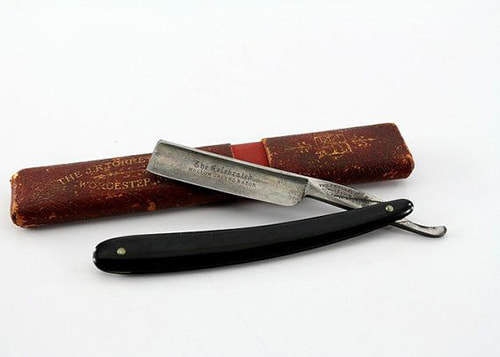
Hope was named in 1882 for a Doctor Hope who was a veterinarian with the Northern Pacific Railroad. But this is a beyond hope story.
It seems that a barber showed up in Sandpoint and worked in a barbershop there for a few days. He was reportedly a handsome, clean-shaven man with graying auburn hair who might have come from Kansas City.
None of that would have made the papers. His last act, did. The Spokesman Review reported that “he came to Hope Thursday evening showing signs of having been under the influence of liquor. During the evening, he flourished a razor in a hotel office and told the night clerk he would prove to the people present that he was a nervy man by cutting his own throat.”
The clerk talked quietly to the man and persuaded him to put the razor away.
But early the next morning the man was back. Quoting the paper, “at 5:30 he walked out onto the platform and five minutes later drew the razor from his breast pocket with his right hand, pulled down his shirt collar with the left hand, threw his head back and a little to one side, then drew the blade across his jugular and cut an awful gash in his throat.”
After that the report gets graphic. Suffice to say the man spent a minute or two dying. No clue about who he was could be found among his effects.
The paper dutifully reported that the coroner ruled the death a suicide.

Published on April 07, 2023 16:00
April 6, 2023
Basque Boarding Houses (tap to read)
Assimilating into a new country and culture is not something that is done overnight. The Basques had some unique ways of coping with the stress of immigration.
You may think of Basques as sheepherders because in this country they often were. For most of them it wasn’t a way of life they had known in the Old Country. It was simply a job that they could learn quickly and one that didn’t require them to take on a new language immediately. The sheep didn’t care what language they spoke.
With themselves for company Basque Sheepherders got along fine during the warm months of the year. But what to do come winter? Their solution was to come together in Basque boarding houses where they could speak the language they knew, eat familiar food, and socialize with their own people. At the same time, the boarding houses were in towns where English was common and they could learn more about their adopted country.
During much of the Twentieth Century you could find Basque boarding houses, or ostatuak, in Boise, Caldwell, Cascade, Emmett, Gooding, Hailey, Jerome, Mackay, Mountain Home, Mullan, Nampa, Pocatelo, Rupert, Shoshone, and Twin Falls. There were more than 50 of them in Boise, alone, including one at the city’s oldest standing brick building, the Jacobs-Uberuaga House (photo), built in 1864. It became a Basque boarding house in 1910. The house is now the physical and historical center of Boise’s Basque Block.
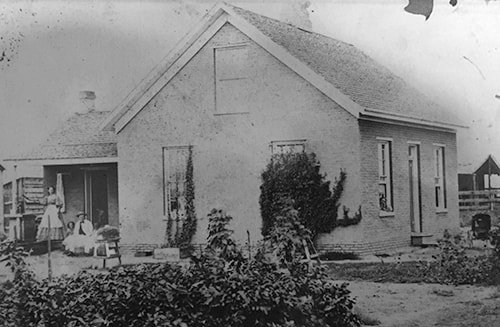
You may think of Basques as sheepherders because in this country they often were. For most of them it wasn’t a way of life they had known in the Old Country. It was simply a job that they could learn quickly and one that didn’t require them to take on a new language immediately. The sheep didn’t care what language they spoke.
With themselves for company Basque Sheepherders got along fine during the warm months of the year. But what to do come winter? Their solution was to come together in Basque boarding houses where they could speak the language they knew, eat familiar food, and socialize with their own people. At the same time, the boarding houses were in towns where English was common and they could learn more about their adopted country.
During much of the Twentieth Century you could find Basque boarding houses, or ostatuak, in Boise, Caldwell, Cascade, Emmett, Gooding, Hailey, Jerome, Mackay, Mountain Home, Mullan, Nampa, Pocatelo, Rupert, Shoshone, and Twin Falls. There were more than 50 of them in Boise, alone, including one at the city’s oldest standing brick building, the Jacobs-Uberuaga House (photo), built in 1864. It became a Basque boarding house in 1910. The house is now the physical and historical center of Boise’s Basque Block.

Published on April 06, 2023 04:00
April 5, 2023
Atoms in the Air! (tap to read)
What if you had an airplane that could circle the globe for years? That question intrigued military planners in the 1940s so much that the National Reactor Testing Station (NRTS), near Idaho Falls, set to work building one. It would run on atomic power, you see.
The atomic airplane would weigh 300 tons, stretch 205 feet long and measure 136 feet from wingtip to wingtip. Big, but smaller than a 747.
The plane was a joint project of the Air Force and the Atomic Energy Commission that began in in 1946. The goal was to come up with a practical airplane that could fly 15,000 miles without having to land.
They built a big earth-shielded hangar for the plane. The photo shows construction and the completed hangar, which last I knew was being used for manufacturing tank armor.
That the plane’s hangar is being used for some other purpose is a clue about the plane itself. They did successfully test twin nuclear engines, but at 30 feet high they were a tad big for airplanes. Miniaturization might have been possible, eventually, if the project weren’t shelved in the early 60s. Technological problems, such shielding the pilots, weren’t what killed it. Fears that such a plane would eventually crash, making the accident site uninhabitable, brought it down before it ever went up, and before a prototype had been built.
Today, you can see the two Heat Transfer Reactor Experiment reactors, used in the effort to build an atomic-powered airplane. They sit in front of the Experimental Breeder Reactor-I Atomic Museum at the site near Arco.
By the way the NRTS became the Idaho National Engineering and Environmental Laboratory (INEEL), then the Idaho National Lab (INL). It retains the latter designation today. Many people in eastern Idaho just call it The Site, rather than keep up with the acronyms.
Information about the nuclear plane comes largely from Susan Stacy’s book Proving the Principle, a History of the National Engineering and Environmental Laboratory, 1949-1999 .

The atomic airplane would weigh 300 tons, stretch 205 feet long and measure 136 feet from wingtip to wingtip. Big, but smaller than a 747.
The plane was a joint project of the Air Force and the Atomic Energy Commission that began in in 1946. The goal was to come up with a practical airplane that could fly 15,000 miles without having to land.
They built a big earth-shielded hangar for the plane. The photo shows construction and the completed hangar, which last I knew was being used for manufacturing tank armor.
That the plane’s hangar is being used for some other purpose is a clue about the plane itself. They did successfully test twin nuclear engines, but at 30 feet high they were a tad big for airplanes. Miniaturization might have been possible, eventually, if the project weren’t shelved in the early 60s. Technological problems, such shielding the pilots, weren’t what killed it. Fears that such a plane would eventually crash, making the accident site uninhabitable, brought it down before it ever went up, and before a prototype had been built.
Today, you can see the two Heat Transfer Reactor Experiment reactors, used in the effort to build an atomic-powered airplane. They sit in front of the Experimental Breeder Reactor-I Atomic Museum at the site near Arco.
By the way the NRTS became the Idaho National Engineering and Environmental Laboratory (INEEL), then the Idaho National Lab (INL). It retains the latter designation today. Many people in eastern Idaho just call it The Site, rather than keep up with the acronyms.
Information about the nuclear plane comes largely from Susan Stacy’s book Proving the Principle, a History of the National Engineering and Environmental Laboratory, 1949-1999 .

Published on April 05, 2023 04:00
April 4, 2023
Idaho's Bottom Border (tap to read)
What would one day become Idaho was the last of 50 states to be entered by Euro-Americans. On August 12, 1805, Meriwether Lewis and his advance party of the Corps of Discovery crossed into future Idaho. Importantly, they also crossed out of the Louisiana Purchase they were sent to explore and into territory claimed by Spain.
Spain’s claims were a bit tenuous. Fourteen years later, they would evaporate in negotiations with Secretary of State John Quincy Adams. By this time, Spain would be embroiled in civil war, leaving it without troops to vigorously defend its claims. President James Monroe was more interested in acquiring Florida from Spain than the distant and, perhaps, worthless lands of the Pacific Northwest. Spain’s claim to Florida was practically ancient compared with its hold on the Western lands of North America. The country’s hold on Florida dated back to 1513 when Juan Ponce de Leon sailed to the peninsula, naming it La Florida, “land of flowers.”
Secretary Adams was adamant about the young country stretching from coast to coast, and negotiated much longer than the president would have preferred. Finally, on February 22, 1819, Spanish Minister Plenipotentiary to the United States Luis do Onis met with Secretary of State Adams to sign a treaty. They had agreed that Spain would give up Florida, but also that the two countries would settle on the 42nd Parallel west to the Pacific Ocean as the boundary between their territories.
Florida and Idaho have little else in common, but they did come under the dominion of the United States on the same day.
That 1819 treaty set the southern border of what would become Idaho and Oregon.
My source for this post is the very readable book called Inventing Idaho, by Keith C. Peterson. If you’re at all a student of Idaho history, it needs to be in your library.
 Then Secretary of State John Quincy Adams, left, and Spanish Minister Plenipotentiary to the United States Luis do Onis negotiated the southern border of what would become Idaho.
Then Secretary of State John Quincy Adams, left, and Spanish Minister Plenipotentiary to the United States Luis do Onis negotiated the southern border of what would become Idaho.
Spain’s claims were a bit tenuous. Fourteen years later, they would evaporate in negotiations with Secretary of State John Quincy Adams. By this time, Spain would be embroiled in civil war, leaving it without troops to vigorously defend its claims. President James Monroe was more interested in acquiring Florida from Spain than the distant and, perhaps, worthless lands of the Pacific Northwest. Spain’s claim to Florida was practically ancient compared with its hold on the Western lands of North America. The country’s hold on Florida dated back to 1513 when Juan Ponce de Leon sailed to the peninsula, naming it La Florida, “land of flowers.”
Secretary Adams was adamant about the young country stretching from coast to coast, and negotiated much longer than the president would have preferred. Finally, on February 22, 1819, Spanish Minister Plenipotentiary to the United States Luis do Onis met with Secretary of State Adams to sign a treaty. They had agreed that Spain would give up Florida, but also that the two countries would settle on the 42nd Parallel west to the Pacific Ocean as the boundary between their territories.
Florida and Idaho have little else in common, but they did come under the dominion of the United States on the same day.
That 1819 treaty set the southern border of what would become Idaho and Oregon.
My source for this post is the very readable book called Inventing Idaho, by Keith C. Peterson. If you’re at all a student of Idaho history, it needs to be in your library.
 Then Secretary of State John Quincy Adams, left, and Spanish Minister Plenipotentiary to the United States Luis do Onis negotiated the southern border of what would become Idaho.
Then Secretary of State John Quincy Adams, left, and Spanish Minister Plenipotentiary to the United States Luis do Onis negotiated the southern border of what would become Idaho.
Published on April 04, 2023 04:00
April 3, 2023
Lawyer in a Statue (tap to read)
This statue is in the park next to the Borah Station Post Office near the statehouse in Boise. It’s called Hospitality of the Nez Perce. It depicts Nez Perce Chief Twisted Hair discussing area geography with Meriwether Lewis and William Clark in Sept 1805. The chief’s son, Lawyer, portrayed at about age eight, inspects trade items at their feet: Nez Perce camas roots, a salmon, Euro-American cloth, and a knife.
Lawyer, or Hallalhotsoot as he was known to the Nez Perce, would become a chief himself in later life and play a prominent role in the Flight of the Nez Perce.
Doug Hyde created the statue. He is a nationally acclaimed Native American artist and Nez Perce descendant who grew up in Lewiston. The statue was donated to the State of Idaho in 2006 by Carol MacGregor, an Idaho native who was a rancher, professor, and the author of several books on Idaho history.
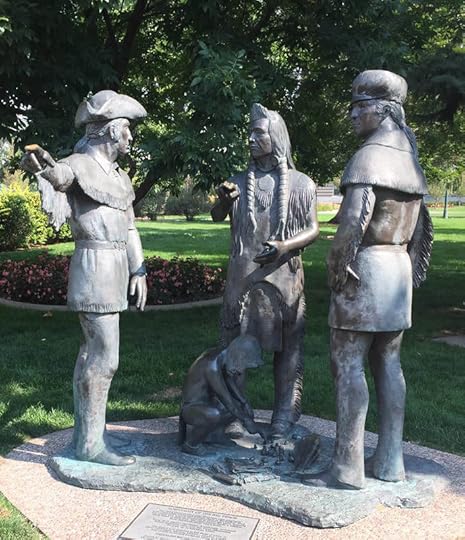
Lawyer, or Hallalhotsoot as he was known to the Nez Perce, would become a chief himself in later life and play a prominent role in the Flight of the Nez Perce.
Doug Hyde created the statue. He is a nationally acclaimed Native American artist and Nez Perce descendant who grew up in Lewiston. The statue was donated to the State of Idaho in 2006 by Carol MacGregor, an Idaho native who was a rancher, professor, and the author of several books on Idaho history.

Published on April 03, 2023 04:00
April 2, 2023
The Wallaces (tap to read)
William H. Wallace was Idaho’s first territorial governor and first congressional delegate. He had previously been Washington Territory’s delegate and territorial governor, so he had some experience under his belt. He also had a high-level friend, President Abraham Lincoln, whom he had known since the early 1850s.
Lincoln appointed Wallace governor while he was in Washington, DC representing Washington Territory. Wallace struck out for the new territory the fastest way possible, which was a 7,000-mile journey by sea and across the Isthmus of Panama. He arrived in Lewiston, the territorial capital, on July 23, 1863. He called the Territorial Legislature together in October, and one of their first decisions was to send Wallace back to Washington, DC, this time as the territorial delegate from Idaho.
He was serving there when on Monday, April 10, 1865, President Lincoln invited he and Mrs. Wallace to attend a performance at Ford Theatre the following Friday evening. For reasons unknown, Wallace declined the invitation. Lincoln was set to reappoint Wallace as territorial governor of Idaho, but that plan was dashed when the president was shot at the theatre. Wallace became one of Lincoln’s pallbearers.
I delight in telling the often-unimportant trivia associated with a story that sometimes makes it simmer if not sizzle, so will throw one in here that matters not a whit. Okay, this time, more than one:
1. William Wallace’s brother, David Wallace, served as governor of Indiana.
2. David Wallace’s son (and William Wallace’s nephew) Lew Wallace served as second in command of the court-martial of Lincoln assassination conspirators.
3. Lew Wallace did a sketch of those on trial and later did a well-known painting based on the sketch called The Conspirators.
4. Lew Wallace was named governor of New Mexico by President Hayes.
5. Oh, and Lew Wallace wrote the novel Ben Hur .
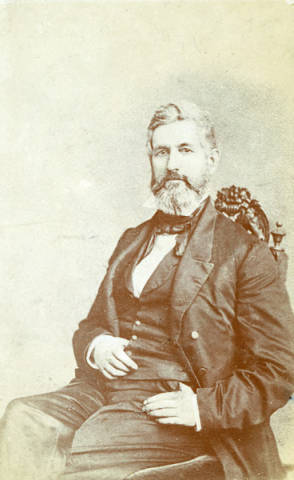
Lincoln appointed Wallace governor while he was in Washington, DC representing Washington Territory. Wallace struck out for the new territory the fastest way possible, which was a 7,000-mile journey by sea and across the Isthmus of Panama. He arrived in Lewiston, the territorial capital, on July 23, 1863. He called the Territorial Legislature together in October, and one of their first decisions was to send Wallace back to Washington, DC, this time as the territorial delegate from Idaho.
He was serving there when on Monday, April 10, 1865, President Lincoln invited he and Mrs. Wallace to attend a performance at Ford Theatre the following Friday evening. For reasons unknown, Wallace declined the invitation. Lincoln was set to reappoint Wallace as territorial governor of Idaho, but that plan was dashed when the president was shot at the theatre. Wallace became one of Lincoln’s pallbearers.
I delight in telling the often-unimportant trivia associated with a story that sometimes makes it simmer if not sizzle, so will throw one in here that matters not a whit. Okay, this time, more than one:
1. William Wallace’s brother, David Wallace, served as governor of Indiana.
2. David Wallace’s son (and William Wallace’s nephew) Lew Wallace served as second in command of the court-martial of Lincoln assassination conspirators.
3. Lew Wallace did a sketch of those on trial and later did a well-known painting based on the sketch called The Conspirators.
4. Lew Wallace was named governor of New Mexico by President Hayes.
5. Oh, and Lew Wallace wrote the novel Ben Hur .

Published on April 02, 2023 04:00
April 1, 2023
Buddy's Boat (tap to read)
This is the US Naval Frigate Pocatello, a patrol frigate that completed a dozen patrols west of Seattle during WWII. Three things are of interest about the otherwise prosaic history of the vessel. First, she was named after the City of Pocatello, Idaho. You may have surmised that. It wasn’t so clear in the AP report about her christening that appeared in the October 18, 1943, edition of the Idaho Statesman. That story had the boat being named for Chief Pocatello, not the city. Since the city was named after Chief Pocatello it is probably a moot point.
The Pocatello was launched from the Kaiser Shipyard in Richmond, California, which leads to the second point of interest. As the AP story reported, “Miss Thelma Dixey, 17, now of Oroville, Calif., sponsored the vessel. She was the granddaughter of Ralph Dixey, prominent Fort Hall Indian and great granddaughter of Chief Pocatello who headed the Shoshone Tribe.
“Miss Dixey swung lustily with the champagne bottle as the ship slid into the waters of San Francisco Bay.
The final item of some interest is that the XO, or executive officer of the ship was Buddy Ebsen, who served aboard the Pocatello until she was decommissioned in 1946. Ebsen was a dancer and actor who appeared in many movies, including Breakfast at Tiffany’s, and became best known for his roles as Jed Clampett in The Beverly Hillbillies , and the title character in the TV series Barnaby Jones.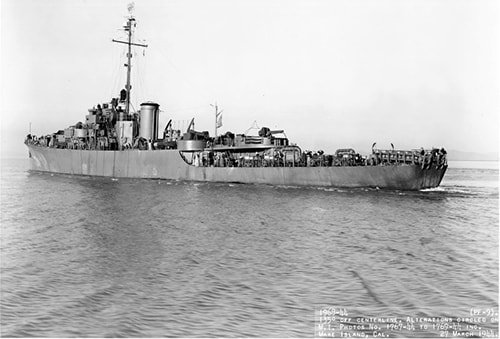
The Pocatello was launched from the Kaiser Shipyard in Richmond, California, which leads to the second point of interest. As the AP story reported, “Miss Thelma Dixey, 17, now of Oroville, Calif., sponsored the vessel. She was the granddaughter of Ralph Dixey, prominent Fort Hall Indian and great granddaughter of Chief Pocatello who headed the Shoshone Tribe.
“Miss Dixey swung lustily with the champagne bottle as the ship slid into the waters of San Francisco Bay.
The final item of some interest is that the XO, or executive officer of the ship was Buddy Ebsen, who served aboard the Pocatello until she was decommissioned in 1946. Ebsen was a dancer and actor who appeared in many movies, including Breakfast at Tiffany’s, and became best known for his roles as Jed Clampett in The Beverly Hillbillies , and the title character in the TV series Barnaby Jones.

Published on April 01, 2023 04:00
March 31, 2023
Snowshoe Wood (tap to read)
It's a shame to look at a hillside covered with dead pine trees. You wonder what got them...fire, insects, disease? Sometimes it's difficult to tell. And sometimes, though they look it, they're not dead at all.
Many of us can't tell one type of tree from another. There are so many different kinds. About the only thing we're sure of is that trees with leaves lose them during the winter, and trees with needles keep them year around. That’s an easy rule... until you run across a tamarack.
The western larch, Larix occidentalis, or tamarack, has needles. Most people would call it a pine tree. But it does the strangest thing in the fall. The tamarack turns orange, or brilliant yellow, then drops its needles.
Tamarack is often mixed in with ponderosa pine, Douglas fir, and lodgepole pine. In the fall the brilliant trees stand out like a scattering of glowing candles among the evergreens.
You can see tamaracks around McCall, in the Little Salmon River country, along the Clearwater River, and many places in northern Idaho. There's a whole hillside due south of New Meadows that is almost covered with tamarack. That's appropriate, because the tiny settlement of Tamarack, Idaho is not far away.
Tamarack wood is heavy and dense. It's often used for utility poles, fence posts, and mine timbers. It doesn't work well in building concrete forms, though. The wood contains a sugar that keeps concrete from curing.
The elves at Wikipedia tell us that the word tamarack is the Algonquian name for the species and means "wood used for snowshoes."

Many of us can't tell one type of tree from another. There are so many different kinds. About the only thing we're sure of is that trees with leaves lose them during the winter, and trees with needles keep them year around. That’s an easy rule... until you run across a tamarack.
The western larch, Larix occidentalis, or tamarack, has needles. Most people would call it a pine tree. But it does the strangest thing in the fall. The tamarack turns orange, or brilliant yellow, then drops its needles.
Tamarack is often mixed in with ponderosa pine, Douglas fir, and lodgepole pine. In the fall the brilliant trees stand out like a scattering of glowing candles among the evergreens.
You can see tamaracks around McCall, in the Little Salmon River country, along the Clearwater River, and many places in northern Idaho. There's a whole hillside due south of New Meadows that is almost covered with tamarack. That's appropriate, because the tiny settlement of Tamarack, Idaho is not far away.
Tamarack wood is heavy and dense. It's often used for utility poles, fence posts, and mine timbers. It doesn't work well in building concrete forms, though. The wood contains a sugar that keeps concrete from curing.
The elves at Wikipedia tell us that the word tamarack is the Algonquian name for the species and means "wood used for snowshoes."

Published on March 31, 2023 04:00



